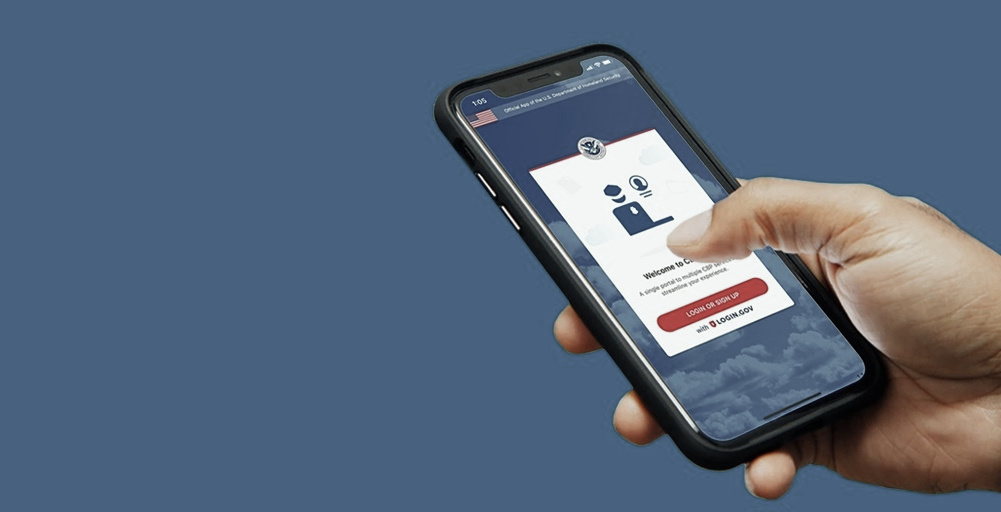On January 5, the U.S. Department of Homeland Security (DHS) announced new measures to process people seeking asylum at ports of entry on the U.S.-Mexico border who are asking to be exempt from Title 42 on humanitarian grounds. Following the announcement, details emerged about how the agency plans to leverage the use of the CBP One app. U.S. Customs and Border Protection (CBP) developed the app to expedite the interactions between individuals arriving at ports of entry and border officers, which can potentially help reduce the time people are detained during their initial inspections and improve the process overall.
CBP One uses facial recognition technology and GPS tracking to perform several of its functions, subjecting users to the inherent risks and flaws of these technologies. Information about these functions and the app’s data collection capabilities is scattered and often buried in dense government documents. This has left many concerns unanswered. CBP’s website also lacks sufficient detail to understand how the app is used.
Despite the lack of information about CBP One, the agency continues to expand the use of the app. All people who wish to access new programs announced by the Biden administration—including the parole programs for Cubans, Haitians, Nicaraguans, and Venezuelans—will be required to use the app.
CBP One’s Original Uses
Launched in October 2020, CBP One initially had three uses:
- Provide information and services related to Form I-94, DHS’ arrival and departure records issued to travelers admitted into the United States,
- Help international organizations and registered users verify whether individuals were enrolled in the Migrant Protection Protocols (MPP) or to submit biographic information prior to arrival at ports of entry and apply for an exemption to Title 42, the law being used by the government to expel potential asylum-seekers based on the COVID-19 pandemic.
- Schedule appointments for inspection of perishable cargo.
What Are CBP One’s New Uses?
Individuals who wish to apply for parole through the new humanitarian parole programs now must use CBP One.
On October 19, 2022, DHS announced the creation of a program allowing a set number of Venezuelans with a sponsor in the United States to apply for humanitarian parole. This program uses DHS’ Advance Travel Authorization (ATA) process to collect information from noncitizens requesting advance authorization to enter the United States and seek a discretionary grant of parole.
The ATA process requires applicants to submit their biometric and biographical information, including photographs, to CBP through CBP One. On January 5, DHS announced the expansion of this process to Cubans, Haitians, and Nicaraguans, which jointly became known as the CHNV.
CBP also expanded the use of CBP One so that asylum seekers could request an exemption to Title 42 directly through the app, bypassing the previous requirement of submitting those requests via nongovernmental organizations.
Asylum seekers coming to the United States can download CBP One on a cell phone. This function becomes available once users are within central or northern Mexico, and the app verifies users’ location using their phones’ GPS. Once users can access this function, the app allows them to enter their own information into CBP systems and schedule a processing appointment.
CBP One Concerns
Despite the agency’s assurances that CBP One’s use is voluntary, a careful review of the available information shows this is no longer true. For example, U.S. Citizenship and Immigration Services’ (USCIS) webpage describing the process for CHNV applicants states that individuals “must” submit their information using CBP One. DHS’ Privacy Impact Assessment for the ATA confirms that alternatives to using the app include applying for humanitarian parole through USCIS, which carries a higher evidentiary burden, or obtaining a visa, for which many potential CHNV applicants will not be eligible.
Further, it is unclear whether CBP One will be the only method for obtaining an appointment for processing at ports of entry. CBP’s factsheet about this function says applicants “may” use CBP One but does not mention alternative methods for entering information. The government has not indicated whether resources will be available for processing of people who do not have appointments made via CBP One.
By forcing people to use CBP One—either explicitly or because individuals do not have a viable alternative—CBP is subjecting users to the app’s flaws. For example, CBP hasn’t addressed how the app’s facial recognition technology may disproportionately fail to identify people of color. If the app erroneously denies users access to these new processes, individuals like asylum seekers may be exposed to unnecessary dangers.
Additionally, DHS indicated that the information collected through CBP One may be used by other agency components and can be shared with other law enforcement agencies. DHS states that GPS location information from CBP One cannot be used by the agency to track individuals. But it is unquestionable that when a person uses certain CBP One app functions, CBP can verify whether a user is located within the geographic zone of accessibility.
Initiatives to improve efficiency of border processing must guarantee access to all those who seek to be processed. Equitable access is essential to the safe and humane treatment of people fleeing harsh conditions in their home countries. The Biden administration has touted CBP One as a tool to streamline processing at the border, but DHS has not been transparent with the public about the app’s functions and its plans to expand its use in the future. This lack of information forces users to comply with CBP One’s terms or risk not being able to access humanitarian immigration processes.
Concise, accessible, and timely information about CBP One, as well as clear information about the availability of alternative methods for those who wish to not use the app, are crucial to ensuring that CBP One meets the intricate balance between efficiency, access, and transparency. CBP One has a long way to go.
FILED UNDER: CBP One Risks, Customs and Border Protection


